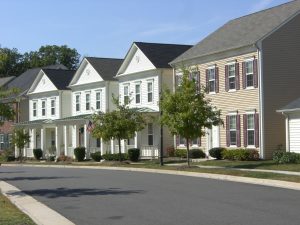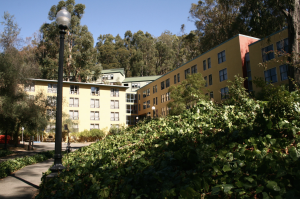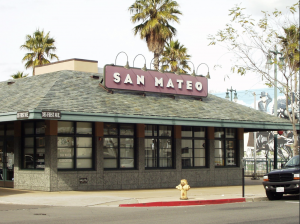by Hannah Phalen
Executive Summary:
The rising popularity of living and working in the Bay Area has contributed to one of the worst housing crises in the world. As more people arrive, housing space fills and pushes people with the lowest income out of the market. Many minority and low-income households are unable to access homeownership, and even those who can afford a home have difficulties finding one due to construction costs, restrictive zoning laws, and high demand. Home sale prices have more than doubled in many neighborhoods, and the extreme competition for housing has driven up prices and credit standards.1 As homeownership becomes increasingly inaccessible, people are forced into the rental market and still struggle to afford monthly payments. It is clear an alternative is needed. Nationally, privately owned housing makes up 96.3 percent of homes; the remaining 3.7 percent is “social housing,” including government-owned housing and non-profit community-based models. If these models went mainstream, more people would have access to affordable options that they need which the market does not currently provide enough of. As housing gets less affordable and homeownership less attainable, more people end up with nowhere to go. It is typically less expensive to provide people with decent housing than it is to take care of their needs including temporary shelter and health when they are without a stable home². Alternative social housing models like community land trusts, limited equity cooperatives, tenant syndicates, and mutual aid housing cooperatives have solved the failure to provide effective, efficient, equitable and permanent homes in other communities. In analyzing the tradeoffs between these criteria, this report’s recommendation for the best alternative housing plan for the communities of Oakland or the larger Bay Area would be to incentivize and fund community land trusts (CLTs) to increase housing accessibility. As director of Oakland’s Housing & Community Development Department, I urge you to consider my recommendation based on the research provided below.
Problem Definition & Background Information:
There is a missed opportunity in providing affordable housing to Bay Area residents by not incentivizing or funding alternative housing options. Low-income households, people of color, gender-nonconforming people, and people with a criminal record are being excluded from the competitive housing market and lack alternative options. I have lived in the Berkeley Student Cooperatives for over three years now and have witnessed the enormous benefits and opportunities that the organization has brought to thousands of students, both from Berkeley and other colleges and universities in the area. I have also completed an internship at the East Bay Permanent Real Estate Cooperative doing research on identifying ways to reach out to the public and gage local interest in collectively purchasing property, as well as attended the NASCO Institute, a conference that explores cooperative models and how to navigate them. While I have learned a lot of the behind-the-scenes actions that goes on in these alternative housing models, it is difficult to determine specific policies or incentives that would grow the movement and provide affordable housing to more East Bay residents. With this memo, I intend to research these possibilities and answer the following questions:
- Can providing more alternative housing improve the impact of the East Bay housing crisis on low-income individuals and families?
- If so, how can we incentivize the creation and maintenance of these properties?
Exploring alternative housing is crucial as Bay Area cities are facing housing and homelessness crises. Oakland’s unsheltered homeless population has risen by over 39 percent since 2015.3 There are zero housing units in Oakland that a full-time minimum wage worker or even an entry-level teacher could afford. They would respectively have to spend 112 percent or 72 percent of their average income in order to live in an average priced one bedroom apartment.4 While thousands of units have been built in Berkeley and Oakland in recent years, it is not nearly enough. The Bay Area housing market is the United States’ most undersupplied market due to the high cost of construction and prohibitive zoning laws. Because of this, developers and property owners are looking into creating micro-units, prefabricated units, modular units, and accessory dwelling units as they are cheaper and easier to build. Most homes in the Bay Area are only occupied by two people and have an average size of a couple thousand square feet, which would mean each individual is taking up more square space than they need or use.5 Most alternative housing which already exists in the Bay Area is in the form of group living run by and for students, or based off their models. Students have been active in the process of creating cooperatives of various sorts and even in campaigning for legislation changes to make group living a more stable option. Some groups of people have used student housing as an alternative to create their own alternative homes, such as professionals in San Francisco who have moved into “dorms” with shared bathrooms and kitchens. Residents in Starcity, one of these dorm-style housing units, have said that the shared bathrooms is the hardest part, but overall most of them share a sense of freedom in splitting household chores and not having to run an entire household alone, enjoy the sense of community and social opportunities, and save costs by sharing spaces where they “eat food, drink wine, and watch TV” among other activities you do at home.6 Additionally, 300 worker-owned small businesses in the United States show well-documented benefits to the businesses and employees using the cooperative system. The Democracy at Work Institute found that employee-owned small businesses see, on average, 4 to 5 percent higher productivity levels, lower employee turnover rates, more stability and potential for growth, and higher profits and worker wages.7 While co-ops are usually more difficult to create than other business models, the benefits are long-lasting and sustainable. They provide more incentives for employees to work hard to foster the business, as they have a direct benefit when the company is doing well. Cooperative models do best when there is a market failure, which is exactly what is happening with the Bay Area housing supply. To fix the failing housing market, Bay Area legislators should learn from the success of existing cooperative models and incentivize alternative housing.
Alternatives:
- Maintain the Status Quo: Let present trends continue. The private market regulation of housing and maintaining current tenant/homeowner relationships may be the best option.
- Support Existing Cooperatives in Expanding: Provide financial and social support to existing cooperative models in the area, including the student based organizations, to expand and reach more of the community.
- Community Land Trusts (CLTs): Using a combination of public and private funds, CLTs would buy land throughout the Bay Area and place it into community ownership through a nonprofit. Anyone who develops property on the land owned by the CLT has to agree to costs set by the community, pegged to resident income instead of market rates.8
- Mutual Aid Housing Cooperatives: Groups of people collectively purchase land using grants or collective loans, minimizing risk. Everyone participates in the building and management process, saving labor costs.
Criteria:
- Efficacy: Alternative reduces negative externalities of the housing market failure such as homelessness and an unrealistic percentage of average income spent solely on housing, determining if the alternative is a better option for a greater number of people in the Bay Area than the currently existing system of 30-year mortgages or rental market.
- Permanence: Alternative protects members from market forces or government policies that commonly displace households to provide housing security long-term, in addition to using sustainable and environmentally conscious practices, as moving can be very costly.
- Equity: Alternative provides for historically marginalized populations and is inclusive across race, gender, and class by location and structure. As income gaps grow increasingly over time, historically marginalized populations have been pushed out of the homeowning market and their neighborhoods by populations who are able to pay the higher prices. This displaces families who have been in the area for generations and who may not have the same opportunities to access the jobs and incomes now becoming necessary to live in the Bay Area, creating a lack of diversity and a great social injustice.
Outcomes:
The following section will provide data that helps determine if each alternative will produce a low, medium, or high success rate for each criteria. I then include a matrix and a discussion on which of the alternatives has the highest overall “score” in achieving the necessary criteria.
Maintain the Status Quo:
- Efficacy: The amount of all income groups in the Bay Area paying over 30 percent of their income on rent rose most for low- and very low-income households. Both the years 2000 and 2015 showed nearly three quarters of extremely low-income renters spending more than half their income on rent. Renters of all races and incomes in Alameda County spent an average of 40 percent of their incomes on housing in 20158. For these reasons, this report labels the efficacy of the current system as low.
- Equity: Between 2000 and 2015, low-income Black households in Alameda County living in high-poverty, segregated areas rose from 50 percent to 58 percent, a much higher percentage than other racial groups. In 2015, racial groups had more disparities in access to higher resource neighborhoods than income groups of the same race. Low-income White households were about seven times more likely to live in neighborhoods with better resources than moderate and high-income Black households.9 This report gives the current system a low rating for equity.
- Permanence: Parts of Oakland and Berkeley have lost thousands of low-income Black households while showing increases in low-income Asian and Latinx households and some high-income White households. Low-income Black, Asian and Latinx populations grew in cities such as San Leandro and Hayward. Nearly 40 percent of low-income Black and White Alameda County residents who moved in 2015 left the Bay Area.10 Many Californians are leaving the state for more affordable housing in states such as Texas, Washington and Arizona. Higher-skilled migrants are replacing lower-skilled migrants in California.11 For these reasons, this report gives the current system a low rating for permanence.
Support Existing Local Student Cooperatives in Expanding:
- Efficacy: The Berkeley student cooperatives (BSC) serve 1,260 student residents in Berkeley, The waitlist at the end of 2017 had over 1,400 people on it, showing that the interest in living here is very high and needed for many students.12 It works very well for the student system, but gets much more complicated as people get older, start families, and need more flexibility in their living space. While it may be effective for a large number of people, I do not believe expanding the student model would be effective for everyone affected by the Bay Area housing crisis, and have labeled this section medium.
- Equity: 60 percent of BSC are low-income, 45 percent first generation college students, and 14 percent are students with disabilities in 2017. Many members have said that they would not be able to pursue their education without the affordable housing provided by the BSC.13 Because the model is built to provide for marginalized populations and prioritize housing them, this report labels this section as high.
- Permanence: The BSC is only for current students at any local college or university. They are not permanent households and do not allow for eventually owning property. Parts of their shared work or democratic policy models could be copied or altered to provide similar, more permanent housing for people who are out of college or not pursuing a degree. A system for this does not exist on a widespread scale yet, and would involve designing a new model, which could be costly and complicated. For this reason, this report rates the permanence factor of this alternative as low.
Community Land Trusts (CLTs)14
- Efficacy: CLTs separate land from the cost of housing, sell ground leases below market levels, and restrict resale. Around 300 CLTs in the US provide approximately 12,000 affordable housing units available to low-income people. Of 17 CLTs in low-income urban areas where the median income is less than $20,000, Picture the Homeless found that 70 percent of the organizations house formerly homeless people and 77 percent serve households making less than $30,000 per year. It is a form of decommodified housing that would help the most underserved residents of the Bay Area afford a home. Because CLTs have served low-income and homeless populations elsewhere, the same groups of people suffering from the Bay Area housing market prices, this report rates the outcome for efficacy as high as it will make a direct impact on those most needing alternative home options.
- Equity: CLTs use participatory planning and direct democracy. Mixed ownership options, including private ownership with resale restrictions, cooperatives, and rentals give members choice in their preferred model. By owning the land, communities can welcome people who face discrimination in the private market, and typically do not check for criminal background or immigration status. Many CLTs prioritize people of color and design board and residency structures to ensure the community is accurately reflected. Many CLTs use rent subsidies and mortgage assistance programs to include low-income residents. These aspects of the CLT model give it a high outcome for equity.
- Permanence: CLTs offer 99-year land leases for owners. Mortgage delinquency and foreclosure rates are lower on CLTs than on homes with prime loans and significantly lower than those with subprime loans, and typically have fewer evictions than housing on the private market. The permanence of CLTs incentivize residents to use more sustainable materials, and systems for water and energy. This would provide the opportunity for those in the Bay Area who were housed by a CLT to remain in that space permanently, or until they voluntarily moved. The CLT permanence outcome is high.
Mutual Aid Housing Cooperatives (MAHCs)15
- Efficacy: MAHCs provide affordable housing for some of the poorest urban and rural residents in Latin America. The mutual aid of residents, tax exemptions, and solidarity funds covering payments for unemployed residents provided in the Uruguay model add to the affordability. 15 percent to 20 percent of costs are typically eliminated by mutual aid building and administrative work. Based on how well it has worked in Uruguay, MAHCs could have a huge impact on improving housing costs for low-income or homeless people. For efficacy, MAHCs get an outcome rating of high.
- Equity: MAHCs encourages women, children, the elderly and people with disabilities to have active roles in the construction and democratic practices in governance of the land. While this encouragement is promising, there are not inherent parts of the model that insure marginalized populations get priority. MAHCs outcome for equity is medium.
- Permanence: Each family has legal rights to use and pass down their home to future generations. Unity, solidarity, and collective action among cooperative members allow them to secure government support and challenge any attempts to reduce or eliminate funding for the cooperatives. The Uruguayan models generally have high quality construction and large livable areas compared to other housing in Uruguay. Buildings are well maintained due to members making their own repairs. Permanence rating is high due to these functions.
The matrix below shows the scores of all alternatives and criteria to easily compare:
| Efficacy | Equity | Permanence | |
| Maintain the Status Quo | LOW | LOW | LOW |
| Support Existing Local Student Cooperatives in Expanding | MEDIUM | HIGH | LOW |
| Community Land Trusts | HIGH | HIGH | HIGH |
| Mutual Aid Housing Cooperatives | HIGH | MEDIUM | HIGH |
Trade-Offs:
This report has shown that the current model, the only option given to almost all homebuyers or renters in the Bay Area, is causing more of a disparity in wealth and opportunity disparity among classes and races, while driving marginalized populations to have to move out of their homes, their neighborhoods, and even the state of California. There is clear interest in alternative models, which have worked very well in student populations, and in many other cities and countries. While the current market system allows many people to increasingly gain capital when they purchase a home, it is not working in the Bay Area where housing is limited and people are ending up on the streets, unable to afford mortgage or monthly rent. The Berkeley Student Cooperatives have made a huge impact on the student population of the East Bay, providing low cost housing for thousands of local students every year. While the efficacy of their model is high for the student populations they already serve, it would not make as much sense for families or working adults. Their model is not meant to be permanent like the models of community land trusts or mutual aid housing cooperatives. CLTs and MAHCs could both provide very promising outcomes if they existed in a widespread scale in the Bay Area. However, CLTs already exist in a number of cities in the United States, while MAHCs are primarily in other countries. The model has been attempted and successful and there are already a few CLTs beginning to grow in the Bay Area. This alone shows that there is something about CLTs that can be more successful than other models. They just need more public funding, land, and government support.
Recommendation & Conclusion:
Reports by the California Housing Partnership Corporation show that policies and investments are needed to provide alternative housing options in the Bay Area which would stabilize areas where rents are rising disproportionately fast, causing low-income people of color to be at risk of displacement as higher income people move into the area and create opportunities for marginalized people to live in higher resource areas that they historically have been excluded from. Alternative housing would provide an opportunity for what their report states is needed: “preserving and expanding the important place low-income communities of color have in [the Bay Area’s] landscape, and for increasing their long-term economic prospects in the region.”16 This memo has shown that community land trusts have the most potential of the alternatives researched to provide housing opportunities to people suffering from the lack of affordable housing in the Bay Area. Because CLTs are able to sell ground leases below market value through separation of land from the cost of housing, and restrict resale, they are a sustainable way to provide low cost housing to the people who need it most. There are already at least 300 CLTs in the United States that shelter thousands of people, the majority of which are low income families or formerly homeless. These people have more of a voice in their housing preferences than other affordable housing models have shown through their use of participatory planning and direct democracy. Residents have mixed ownership or renting options, the only major restriction being on resale which keeps it affordable. There are not discriminatory acceptance policies to keep out potential residents based on their identity as undocumented, formerly incarcerated, LGBTQ+, race, or any other factor. Through 99-year land leases and low eviction rates, CLTs insure that once families move in, they have the option to remain in their home for as long as they want. The model already exists and is thriving, it just needs to be more widespread to serve more people. For all these reasons, I firmly believe that the people of the Bay Area would benefit immensely from the option to live in a community land trust area. As director of Oakland’s Housing & Community Development Department, I hope that you will introduce this idea and push for more funding and support to make sure more CLTs exist in Oakland and the greater Bay Area.
Endnotes
1. Ganesh, Bhargavi, et al. “The Bay Area’s Housing Crisis, in Four Charts.” Urban Institute, 22 May 2018, www.urban.org/urban-wire/bay-areas-housing-crisis-four-charts.
2. Anzilotti, Eillie. “4 Radical Real Estate Ideas To Fix Our Broken Housing System.” Fast Company, Fast Company, 23 Mar. 2018, www.fastcompany.com/40547215/4-radical-real-estate-ideas-to-fix-our-broken-housing-system.
3. Hedin, Mark. “Survey Confirms Oakland Homeless Crisis Growing Worse.” East Bay Times, East Bay Times, 5 June 2017, www.eastbaytimes.com/2017/06/02/survey-confirms-oakland-homeless-crisis-growing-worse/.
4. “Oakland’s Displacement Crisis: As Told by the Numbers.” PolicyLink.
5. Richards, Kathleen. “So, You Think Housing in the East Bay Is Expensive and Scarce?” East Bay Express, East Bay Express, 17 Oct. 2018, www.eastbayexpress.com/oakland/so-you-think-housing-in-the-east-bay-is-expensive-and-scarce/Content?oid=13262905.
6. Bowles, Nellie. “Dorm Living for Professionals Comes to San Francisco.” The New York Times, The New York Times, 5 Mar. 2018, www.nytimes.com/2018/03/04/technology/dorm-living-grown-ups-san-francisco.html.
7. Anzilotti, Eillie. “More U.S. Businesses Are Becoming Worker Co-Ops: Here’s Why.” Fast Company, Fast Company, 21 May 2018, www.fastcompany.com/40572926/more-u-s-businesses-are-becoming-worker-co-ops-heres-why.
8. Anzilotti, Eillie. “4 Radical Real Estate Ideas To Fix Our Broken Housing System.” Fast Company, Fast Company, 23 Mar. 2018, www.fastcompany.com/40547215/4-radical-real-estate-ideas-to-fix-our-broken-housing-system.
9. Anzilotti, Eillie. “4 Radical Real Estate Ideas To Fix Our Broken Housing System.” Fast Company, Fast Company, 23 Mar. 2018, www.fastcompany.com/40547215/4-radical-real-estate-ideas-to-fix-our-broken-housing-system.
10. UC Berkeley’s Urban Displacement Project and the California Housing Partnership. Rising Housing Costs and Re-Segregation in Alameda County. 2018, http://chpc.net/wp-content/uploads/2018/09/AlamedaCoResegregationReport_2018.pdf
11. UC Berkeley’s Urban Displacement Project and the California Housing Partnership. Rising Housing Costs and Re-Segregation in Alameda County. 2018, http://chpc.net/wp-content/uploads/2018/09/AlamedaCoResegregationReport_2018.pdf
12. Murphy, Katy. “Why the Bay Area Is the Epicenter of California’s Housing Crisis.” The Mercury News, The Mercury News, 4 May 2018, www.mercurynews.com/2018/05/03/why-the-bay-area-is-the-epicenter-of-californias-housing-crisis/.
13. Berkeley Students Cooperatives 2017 Annual Report. https://www.bsc.coop/docs/BSCAnnualReport_2017.pdf
14. Berkeley Students Cooperatives 2017 Annual Report. https://www.bsc.coop/docs/BSCAnnualReport_2017.pdf
15. Baiocchi, Gianpaolo. Communities Over Commodities: People-Driven Alternatives to an Unjust Housing System. Homes for All Campaign, 2018, Communities Over Commodities: People-Driven Alternatives to an Unjust Housing System, homesforall.org/wp-content/uploads/2018/03/Communities-Over-Commodities_Full-Report.pdf.
16. Baiocchi, Gianpaolo. Communities Over Commodities: People-Driven Alternatives to an Unjust Housing System. Homes for All Campaign, 2018, Communities Over Commodities: People-Driven Alternatives to an Unjust Housing System, homesforall.org/wp-content/uploads/2018/03/Communities-Over-Commodities_Full-Report.pdf.
17. UC Berkeley’s Urban Displacement Project and the California Housing Partnership. Rising Housing Costs and Re-Segregation in Alameda County. 2018, http://chpc.net/wp-content/uploads/2018/09/AlamedaCoResegregationReport_2018.pdf








Be First to Comment